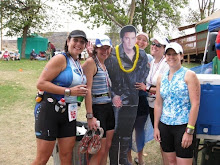
THE THERAPIST CAN WAIT Michael and Briana Boehmer use foam rollers for a do-it-yourself massage that helps prevent sore muscles from workouts.
AS a former cross-country runner for the University of Wisconsin-Madison, where a free massage was part of an athlete’s weekly schedule, Briana Boehmer remembers the benefits of having qualified hands work her sore muscles.
Now that she is 30 and starting a corporate wellness business with her husband, Mrs. Boehmer no longer enjoys such a perk, so she massages her muscles herself. She works out about seven hours a week, training for triathlons and duathlons, and begins and ends each session by kneading her back and legs on a foam roller, which she calls her “best friend.”
“It’s like getting a massage without having to pay $85 an hour,” she said. “I can’t afford the real thing right now.”
Devices for self-massage have become more common as more people compete in endurance sports and, more recently, as the recession has made professional rubdowns look prohibitively expensive. Trainers usually recommend a massage every week or every other week for people who are training for a marathon or triathlon, but the costs do add up: according to the American Massage Therapy Association, the average price of a massage is $63 an hour.
Though a massage may sound like a luxury, it can become a necessity as part of a training regimen. When the same muscles are forced to do the same motions over and over, they become tight and injury-prone.
For instance, “riding on aerobars on the bike sets up a huge muscle imbalance in the upper back and shoulders,” said Tim Crowley, a triathlon coach in Marlboro, Mass. “Hip flexors, hamstrings and glutes become extremely tight and immobile from running.”
While it’s hard to say how many people do self-massage, many athletes swear by it, and a growing range of products and how-to videos is available in stores and online. A foam roller, which costs about $25, is just one of a family of products, manufactured or improvised, that can relieve tight muscles.
“In the late ’90s, you could only find foam rollers through physical therapy catalogs,” said Keats Snideman, a massage therapist and conditioning coach in Tempe, Ariz., who produced a DVD about self-massage. “Now you can buy them anywhere, and exercises with them are all over YouTube.”
In addition to the many name-brand products that are sold specifically as massage aids, old-fashioned household objects will do, too. Most small balls, including golf, tennis, baseball and lacrosse balls, can unkink sore muscles.
Rich Poley, author of the book “Self-Massage for Athletes,” favors using your own hands. But he is also a fan of the Knobble II, a mushroom-shaped device that can be used to press on muscles at specific trigger points to try to break up knots, and the Thera Cane, a hook that can be used to reach points on the back.
For all its advantages, self-massage has its limitations. Cassidy Phillips, founder of Trigger Point Performance Therapy, considers it the equivalent of oral hygiene. “You brush away some plaque yourself,” he said, “but you still go to the dentist for a thorough cleaning.” His company, based in Austin, Tex., sells self-massage tools for athletes.
Clearly, a massage from a trained therapist can be more effective — and relaxing — than a self-administered massage. A therapist also has a comprehensive knowledge of anatomy and can help with injuries, like muscle strains, that may not respond to self-massage.
“A foam roller can’t alleviate deep trigger points the way an experienced thumb or knuckle can,” said Collette Glass, a sports massage therapist in Atlanta.
Yet Mrs. Glass, whose livelihood depends on athletes who need her care, is a proponent of self-massage. She and her husband, Dr. Josh Glass, a sports chiropractor, hold self-care seminars in the Atlanta area several times a year. “The message we stress through the whole demonstration,” she said, “is that self-massage keeps you out of our offices.”
Any kind of massage —the professional type and the D.I.Y. — can stimulate blood flow and break up scar tissue, thus reducing an athlete’s risk of injury, Mrs. Glass said. “In massage, shortened, overworked muscles get flushed out and return to a normal length, which helps them properly recover,” she said. When she was training for Ironman triathlons in 2006 and 2008, she said, she used a roller every day to soothe her iliotibial bands (tendons that run along the outside of the upper leg).
Jenni Gaertner, a physical therapist and competitive cyclist in Coeur d’Alene, Idaho, also advocates a combination approach. “I go to a massage therapist only during racing season, because it can be so expensive,” she said. “But I use a foam roller year-round and prescribe it to patients and teammates.”
ABBY RUBY, an athlete and coach from Manitou Springs, Colo., massaged her muscles daily while training for a 100-mile trail run in Leadville, Colo., this year. She doesn’t leave home without her tools: half of a foam roller and a small ball from Trigger Point Performance Therapy. “I sit on the ball on flights to release my piriformis,” she said, referring to a muscle deep within the hip and buttock region.
Convenience and affordability are the selling points for Ms. Ruby. “When I need a massage, I need it now, not next Wednesday at 3 p.m.,” she said.





















No comments:
Post a Comment